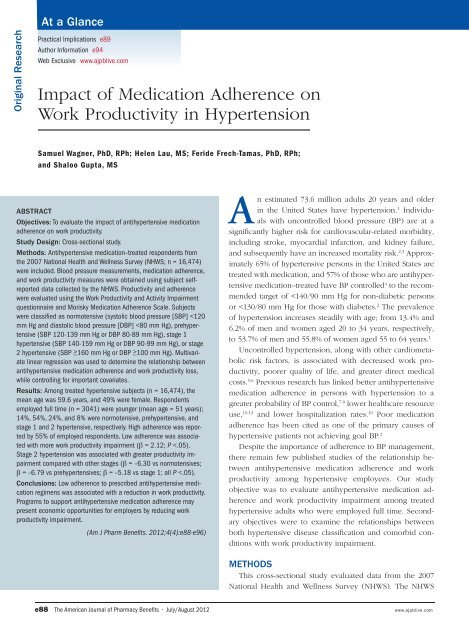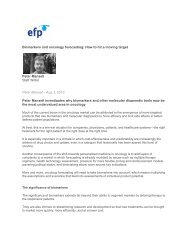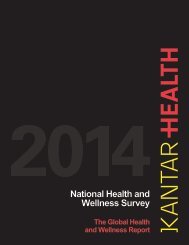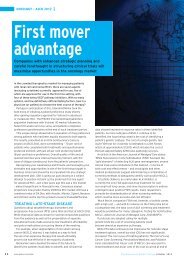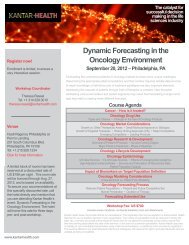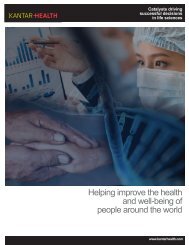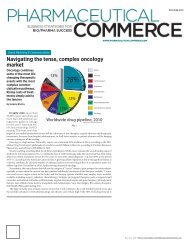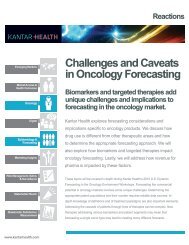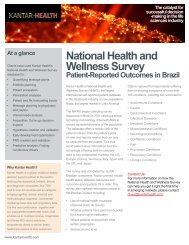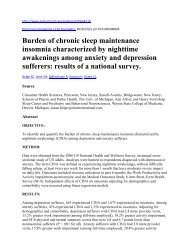Impact of Medication Adherence on Work ... - Kantar Health
Impact of Medication Adherence on Work ... - Kantar Health
Impact of Medication Adherence on Work ... - Kantar Health
Create successful ePaper yourself
Turn your PDF publications into a flip-book with our unique Google optimized e-Paper software.
Original Research<br />
At a Glance<br />
Practical Implicati<strong>on</strong>s e89<br />
Author Informati<strong>on</strong> e94<br />
Web Exclusive www.ajpblive.com<br />
<str<strong>on</strong>g>Impact</str<strong>on</strong>g> <str<strong>on</strong>g>of</str<strong>on</strong>g> <str<strong>on</strong>g>Medicati<strong>on</strong></str<strong>on</strong>g> <str<strong>on</strong>g>Adherence</str<strong>on</strong>g> <strong>on</strong><br />
<strong>Work</strong> Productivity in Hypertensi<strong>on</strong><br />
Samuel Wagner, PhD, RPh; Helen Lau, MS; Feride Frech-Tamas, PhD, RPh;<br />
and Shaloo Gupta, MS<br />
ABSTRACT<br />
Objectives: To evaluate the impact <str<strong>on</strong>g>of</str<strong>on</strong>g> antihypertensive medicati<strong>on</strong><br />
adherence <strong>on</strong> work productivity.<br />
Study Design: Cross-secti<strong>on</strong>al study.<br />
Methods: Antihypertensive medicati<strong>on</strong>–treated resp<strong>on</strong>dents from<br />
the 2007 Nati<strong>on</strong>al <strong>Health</strong> and Wellness Survey (NHWS; n = 16,474)<br />
were included. Blood pressure measurements, medicati<strong>on</strong> adherence,<br />
and work productivity measures were obtained using subject selfreported<br />
data collected by the NHWS. Productivity and adherence<br />
were evaluated using the <strong>Work</strong> Productivity and Activity Impairment<br />
questi<strong>on</strong>naire and Morisky <str<strong>on</strong>g>Medicati<strong>on</strong></str<strong>on</strong>g> <str<strong>on</strong>g>Adherence</str<strong>on</strong>g> Scale. Subjects<br />
were classifi ed as normotensive (systolic blood pressure [SBP] 100 mm Hg). Multivariate<br />
linear regressi<strong>on</strong> was used to determine the relati<strong>on</strong>ship between<br />
antihypertensive medicati<strong>on</strong> adherence and work productivity loss,<br />
while c<strong>on</strong>trolling for important covariates.<br />
Results: Am<strong>on</strong>g treated hypertensive subjects (n = 16,474), the<br />
mean age was 59.6 years, and 49% were female. Resp<strong>on</strong>dents<br />
employed full time (n = 3041) were younger (mean age = 51 years);<br />
14%, 54%, 24%, and 8% were normotensive, prehypertensive, and<br />
stage 1 and 2 hypertensive, respectively. High adherence was reported<br />
by 55% <str<strong>on</strong>g>of</str<strong>on</strong>g> employed resp<strong>on</strong>dents. Low adherence was associated<br />
with more work productivity impairment (β = 2.12; P
Hypertensi<strong>on</strong> <str<strong>on</strong>g>Medicati<strong>on</strong></str<strong>on</strong>g> <str<strong>on</strong>g>Adherence</str<strong>on</strong>g> and Productivity<br />
is a self-administered, Internet-based annual survey <str<strong>on</strong>g>of</str<strong>on</strong>g><br />
63,012 US adults 18 years and older which has been<br />
c<strong>on</strong>ducted in the United States since 1998 by C<strong>on</strong>sumer<br />
<strong>Health</strong> Sciences. 14 Survey participants provide informed<br />
c<strong>on</strong>sent and are sampled to mirror generalized demographic<br />
characteristics (gender, age, and race/ethnicity)<br />
<str<strong>on</strong>g>of</str<strong>on</strong>g> the US populati<strong>on</strong>. The survey sample is drawn from<br />
an Internet panel maintained by Lightspeed Research<br />
(Warren, New Jersey) and includes self-reported informati<strong>on</strong><br />
<strong>on</strong> participant demographic characteristics, medical<br />
history, healthcare utilizati<strong>on</strong>, and healthcare attitudes,<br />
behaviors, and outcomes. The protocol and informed<br />
c<strong>on</strong>sent were reviewed and approved by Essex Instituti<strong>on</strong>al<br />
Review Board, Inc, in Leban<strong>on</strong>, New Jersey. NHWS<br />
resp<strong>on</strong>dents were eligible if they had a self-reported diagnosis<br />
<str<strong>on</strong>g>of</str<strong>on</strong>g> hypertensi<strong>on</strong> and reported use <str<strong>on</strong>g>of</str<strong>on</strong>g> antihypertensive<br />
prescripti<strong>on</strong> medicati<strong>on</strong>. While descriptive statistics<br />
are reported for the entire eligible hypertensive populati<strong>on</strong><br />
with antihypertensive medicati<strong>on</strong> use (n = 16,474),<br />
NHWS resp<strong>on</strong>dents were included in the final sample<br />
used for productivity analyses if they also reported fulltime<br />
employment (n = 3041).<br />
<str<strong>on</strong>g>Medicati<strong>on</strong></str<strong>on</strong>g> adherence was estimated using the<br />
Morisky <str<strong>on</strong>g>Medicati<strong>on</strong></str<strong>on</strong>g> <str<strong>on</strong>g>Adherence</str<strong>on</strong>g> Scale (MMAS) as a proxy<br />
for medicati<strong>on</strong> c<strong>on</strong>sumpti<strong>on</strong>. 15-19 The MMAS has been<br />
shown to be a reliable instrument (reliability α = 0.61),<br />
and dem<strong>on</strong>strated both c<strong>on</strong>current and predictive validity<br />
with regard to BP c<strong>on</strong>trol at both 2 and 5 years, respectively.<br />
15 The MMAS c<strong>on</strong>sists <str<strong>on</strong>g>of</str<strong>on</strong>g> the following 4 questi<strong>on</strong>s<br />
which are scored using a 0/1 resp<strong>on</strong>se scale corresp<strong>on</strong>ding<br />
to no/yes answers, respectively: “With regard to your<br />
high blood pressure medicati<strong>on</strong>s: 1) Do you ever forget<br />
to take your medicine? 2) Are you careless at times<br />
about taking your medicine? 3) When you feel better do<br />
you sometimes stop taking your medicine? and 4) Sometimes<br />
if you feel worse when you take your medicine,<br />
do you stop taking it?” Resp<strong>on</strong>dent scores to the MMAS<br />
are calculated as the sum <str<strong>on</strong>g>of</str<strong>on</strong>g> the 4 questi<strong>on</strong> resp<strong>on</strong>ses;<br />
the sum is used to categorize resp<strong>on</strong>dents as having high<br />
adherence (MMAS = 0 “yes” resp<strong>on</strong>ses) or low adherence<br />
(MMAS = 1-4, or at least 1 “yes” resp<strong>on</strong>se). Due to<br />
a small percentage (3, MMAS scores <str<strong>on</strong>g>of</str<strong>on</strong>g> 1 to 4 were collapsed<br />
into 1 group. This categorizati<strong>on</strong> has been reported in<br />
previous research. 17,20-22<br />
<strong>Work</strong> productivity and activity impairment were measured<br />
using the general health versi<strong>on</strong> <str<strong>on</strong>g>of</str<strong>on</strong>g> the <strong>Work</strong> Productivity<br />
and Activity Impairment Questi<strong>on</strong>naire: General<br />
<strong>Health</strong> (WPAI:GH). 23 The WPAI:GH is a 6-item, quantitative,<br />
self-reported evaluati<strong>on</strong> <str<strong>on</strong>g>of</str<strong>on</strong>g> the level <str<strong>on</strong>g>of</str<strong>on</strong>g> absenteeism,<br />
PRACTICAL IMPLICATIONS<br />
This study included self-reported data <strong>on</strong> antihypertensive medicati<strong>on</strong>–treated<br />
resp<strong>on</strong>dents from the 2007 Nati<strong>on</strong>al <strong>Health</strong> and Wellness<br />
Survey (NHWS; n = 16,474) and a subset <str<strong>on</strong>g>of</str<strong>on</strong>g> subjects who were<br />
employed full time (n = 3041).<br />
n A reducti<strong>on</strong> in work productivity was reported by n<strong>on</strong>adherent subjects,<br />
primarily associated with productivity while at work.<br />
n Stage 2 hypertensive resp<strong>on</strong>dents reported more work productivity<br />
impairment than other hypertensive subjects, and the number <str<strong>on</strong>g>of</str<strong>on</strong>g><br />
comorbidities was associated with work productivity impairment.<br />
n Since an associati<strong>on</strong> was found between n<strong>on</strong>adherence and<br />
poorer outcomes, programs to support antihypertensive medicati<strong>on</strong><br />
adherence present ec<strong>on</strong>omic opportunities for employers by<br />
improving work productivity.<br />
presenteeism, and daily activity impairment attributable<br />
to general health during the prior 7 days. Activity impairment<br />
was evaluated for all NHWS resp<strong>on</strong>dents, while<br />
work productivity measures were assessed for resp<strong>on</strong>dents<br />
who reported full-time employment. Am<strong>on</strong>g fulltime<br />
employed subjects, the following were evaluated:<br />
absenteeism (the percent <str<strong>on</strong>g>of</str<strong>on</strong>g> work time missed due to<br />
health reas<strong>on</strong>s, or the number <str<strong>on</strong>g>of</str<strong>on</strong>g> hours missed during<br />
the last 7 days as a percentage <str<strong>on</strong>g>of</str<strong>on</strong>g> the sum <str<strong>on</strong>g>of</str<strong>on</strong>g> the hours<br />
missed plus the hours actually worked), presenteeism<br />
(the percent <str<strong>on</strong>g>of</str<strong>on</strong>g> impairment while working due to health<br />
reas<strong>on</strong>s, or the degree that health affected productivity<br />
while working as a percentage <str<strong>on</strong>g>of</str<strong>on</strong>g> the maximum possible<br />
impairment), and overall work productivity loss (percent<br />
<str<strong>on</strong>g>of</str<strong>on</strong>g> overall work impairment due to health, or absenteeism<br />
plus presenteeism). 24<br />
Self-reported BP levels were also obtained as part <str<strong>on</strong>g>of</str<strong>on</strong>g><br />
the NHWS. Resp<strong>on</strong>dents were asked, “What was your last<br />
blood pressure reading?” to obtain estimates <str<strong>on</strong>g>of</str<strong>on</strong>g> systolic BP<br />
(SBP) and diastolic BP (DBP) measurements which were<br />
used to classify participants according to the Seventh<br />
Report <str<strong>on</strong>g>of</str<strong>on</strong>g> the Joint Nati<strong>on</strong>al Committee <strong>on</strong> Preventi<strong>on</strong>,<br />
Detecti<strong>on</strong>, Evaluati<strong>on</strong>, and Treatment <str<strong>on</strong>g>of</str<strong>on</strong>g> High Blood Pressure<br />
(JNC 7)–defined stages <str<strong>on</strong>g>of</str<strong>on</strong>g> hypertensi<strong>on</strong>, based <strong>on</strong><br />
highest reported SBP or DBP levels: normotensive (SBP<br />
100<br />
mm Hg). 2 The presence <str<strong>on</strong>g>of</str<strong>on</strong>g> more than 140 other comorbid<br />
c<strong>on</strong>diti<strong>on</strong>s, including diabetes, dyslipidemia, arthritis,<br />
insomnia, and anxiety, was ascertained by resp<strong>on</strong>dent<br />
self-report, and total number <str<strong>on</strong>g>of</str<strong>on</strong>g> comorbid c<strong>on</strong>diti<strong>on</strong>s per<br />
www.ajpblive.com<br />
Vol. 4, No. 4 • The American Journal <str<strong>on</strong>g>of</str<strong>on</strong>g> Pharmacy Benefits e89
n Wagner • Lau • Frech-Tamas • Gupta<br />
Table 1. Demographic and Clinical Characteristics <str<strong>on</strong>g>of</str<strong>on</strong>g> Hypertensive Subjects Reporting Antihypertensive <str<strong>on</strong>g>Medicati<strong>on</strong></str<strong>on</strong>g> Use<br />
(n = 16,474)<br />
Total<br />
(n = 16,474)<br />
Low <str<strong>on</strong>g>Adherence</str<strong>on</strong>g> (MMAS = 1-4)<br />
(n = 5580; 33.9%)<br />
High <str<strong>on</strong>g>Adherence</str<strong>on</strong>g> (MMAS = 0)<br />
(n = 10,894; 66.1%) P<br />
Female, % 49.0% 46.5% 50.3%
Hypertensi<strong>on</strong> <str<strong>on</strong>g>Medicati<strong>on</strong></str<strong>on</strong>g> <str<strong>on</strong>g>Adherence</str<strong>on</strong>g> and Productivity<br />
Figure. Demographic and Clinical Characteristics <str<strong>on</strong>g>of</str<strong>on</strong>g> Nati<strong>on</strong>al <strong>Health</strong> and Wellness Survey Hypertensive Subjects Reporting<br />
Antihypertensive <str<strong>on</strong>g>Medicati<strong>on</strong></str<strong>on</strong>g> Use and Full-time Employment (n = 3041)<br />
100<br />
90<br />
80<br />
76<br />
70<br />
60<br />
55<br />
62<br />
63<br />
56<br />
%<br />
50<br />
40<br />
30<br />
20<br />
10<br />
0<br />
20<br />
24<br />
High <str<strong>on</strong>g>Adherence</str<strong>on</strong>g><br />
Male<br />
Caucasian<br />
Married<br />
Currently<br />
Smoking<br />
Self-Reported<br />
Diabetes<br />
Self-Reported<br />
Dyslipidemia<br />
Male gender, Caucasian, married status, and self-reported dyslipidemia are the most prevalent characteristics <str<strong>on</strong>g>of</str<strong>on</strong>g> the full-time employed resp<strong>on</strong>dents.<br />
summarized in Table 2. Compared with those with low<br />
adherence (MMAS >0) to antihypertensive medicati<strong>on</strong>s,<br />
resp<strong>on</strong>dents who reported high adherence (MMAS = 0)<br />
had significantly overall less work productivity loss (P<br />
30%) <str<strong>on</strong>g>of</str<strong>on</strong>g> work impairment. Presenteeism was significantly<br />
worse for subjects with low adherence versus high<br />
adherence (P
n Wagner • Lau • Frech-Tamas • Gupta<br />
Table 3. Independent Effects <str<strong>on</strong>g>of</str<strong>on</strong>g> Hypertensi<strong>on</strong> <str<strong>on</strong>g>Medicati<strong>on</strong></str<strong>on</strong>g> <str<strong>on</strong>g>Adherence</str<strong>on</strong>g> <strong>on</strong> <strong>Work</strong> Productivity Loss (n = 3041) a<br />
Parameter Estimate Standard Error 95% CI Lower Limit 95% CI Upper Limit P<br />
Intercept 35.571 5.488 24.810 46.332
Hypertensi<strong>on</strong> <str<strong>on</strong>g>Medicati<strong>on</strong></str<strong>on</strong>g> <str<strong>on</strong>g>Adherence</str<strong>on</strong>g> and Productivity<br />
Our findings are particularly important when c<strong>on</strong>sidered<br />
in the c<strong>on</strong>text <str<strong>on</strong>g>of</str<strong>on</strong>g> the employer burden <str<strong>on</strong>g>of</str<strong>on</strong>g> hypertensi<strong>on</strong>.<br />
Goetzel and colleagues studied the total cost <str<strong>on</strong>g>of</str<strong>on</strong>g><br />
health, absence, short-term disability, and productivity<br />
losses for 10 chr<strong>on</strong>ic diseases using the MedStat MarketScan<br />
<strong>Health</strong> and Productivity Management database,<br />
which c<strong>on</strong>tains informati<strong>on</strong> <strong>on</strong> 374,799 employees over<br />
a 3-year time period. 28 Hypertensi<strong>on</strong> ranked am<strong>on</strong>g the<br />
10 chr<strong>on</strong>ic diseases with the highest total employer cost<br />
burden in this study. The ec<strong>on</strong>omic burden <str<strong>on</strong>g>of</str<strong>on</strong>g> illness for<br />
hypertensi<strong>on</strong>, including inpatient and outpatient services,<br />
prescripti<strong>on</strong> drugs, absenteeism, short-term disability<br />
expenditures, and productivity losses, was estimated at<br />
$392 per employee yearly. Annual productivity losses<br />
due to hypertensi<strong>on</strong> were estimated at $247 per employee.<br />
Lamb and colleagues c<strong>on</strong>ducted a study <str<strong>on</strong>g>of</str<strong>on</strong>g> 8267<br />
US employees from 47 employer locati<strong>on</strong>s to compare<br />
productivity losses for allergic rhinitis with other c<strong>on</strong>diti<strong>on</strong>s,<br />
including hypertensi<strong>on</strong>. The authors found that absenteeism<br />
plus presenteeism accounted for $105 yearly<br />
per employee for hypertensi<strong>on</strong>. 29 It is reas<strong>on</strong>able to infer<br />
then that associati<strong>on</strong> between antihypertensive medicati<strong>on</strong><br />
adherence and decreased work productivity found<br />
in the current study may have cost implicati<strong>on</strong>s from an<br />
employer’s perspective.<br />
Rizzo and colleagues, using data from the nati<strong>on</strong>ally<br />
representative 1987 Nati<strong>on</strong>al Medical Care Expenditure<br />
Survey, estimated the effects <str<strong>on</strong>g>of</str<strong>on</strong>g> prescripti<strong>on</strong> medicati<strong>on</strong><br />
<strong>on</strong> worker productivity for hypertensi<strong>on</strong>, al<strong>on</strong>g with diabetes,<br />
heart disease, and depressi<strong>on</strong>. 30 The authors estimated<br />
that the net benefit to employers during 1987<br />
amounted to $286 per hypertensive employee, $633 per<br />
employee with heart disease, $822 per employee with<br />
depressi<strong>on</strong>, and $1475 per diabetic employee. Average<br />
compliance (63%) with antihypertensive medicati<strong>on</strong>s<br />
saved, <strong>on</strong> average, 3.5 days <str<strong>on</strong>g>of</str<strong>on</strong>g> work annually, compared<br />
with 5.5 days lost for untreated patients. The authors c<strong>on</strong>cluded<br />
that the observed benefits were due to reduced<br />
absenteeism associated with prescripti<strong>on</strong> medicati<strong>on</strong> use<br />
am<strong>on</strong>g employees with chr<strong>on</strong>ic illness.<br />
Suboptimal adherence and persistence to prescribed<br />
antihypertensive regimens has been documented by several<br />
studies in “usual-care” settings, 26,31,32 and l<strong>on</strong>g-term<br />
persistence with antihypertensive therapies is poor. 26,32<br />
Antihypertensive medicati<strong>on</strong> adherence has been identified<br />
as an important c<strong>on</strong>tributor to BP goal attainment. 7,33<br />
Poor antihypertensive medicati<strong>on</strong> adherence is associated<br />
with higher healthcare resource use 10-13 and higher<br />
hospitalizati<strong>on</strong> rates. 10 Previous research has documented<br />
that medicati<strong>on</strong> adherence differs by therapeutic class,<br />
with agents from the angiotensin-receptor blocker (ARB)<br />
class generally associated with slightly higher adherence<br />
and persistence. 26,31,34 Although a few studies have found<br />
a link between adverse effects from antihypertensive<br />
medicati<strong>on</strong> and medicati<strong>on</strong> persistence, 35,36 it is possible<br />
that adverse effects from antihypertensive medicati<strong>on</strong>s<br />
could potentially impact employees to some degree at the<br />
workplace. However, in the current study, antihypertensive<br />
treatment was not associated with work productivity<br />
loss in the multivariate analysis. Am<strong>on</strong>g hypertensive<br />
study subjects who had high adherence to their prescribed<br />
antihypertensive medicati<strong>on</strong> regimen, 21% had<br />
stage 1 hypertensi<strong>on</strong> and 7% had stage 2 hypertensi<strong>on</strong>.<br />
Patients with hypertensi<strong>on</strong> usually require 2 or more different<br />
antihypertensive medicati<strong>on</strong>s to attain goal BP. 2<br />
Additi<strong>on</strong> <str<strong>on</strong>g>of</str<strong>on</strong>g> another class <str<strong>on</strong>g>of</str<strong>on</strong>g> antihypertensive medicati<strong>on</strong><br />
to the existing regimen or a dosage increase <str<strong>on</strong>g>of</str<strong>on</strong>g> the current<br />
regimen would be warranted in these patients. The<br />
failure <str<strong>on</strong>g>of</str<strong>on</strong>g> healthcare providers to intensify medicati<strong>on</strong><br />
regimens despite patients not achieving treatment goals<br />
is <str<strong>on</strong>g>of</str<strong>on</strong>g>ten referred to as “clinical inertia,” which has been<br />
well documented in usual care settings for hypertensive<br />
patients. 37-39 In additi<strong>on</strong> to clinical inertia, other factors<br />
in medicati<strong>on</strong>-compliant patients (such as dietary habits<br />
and obesity) may play a role in failure to attain goal BP;<br />
despite this, however, our findings suggest that a proporti<strong>on</strong><br />
<str<strong>on</strong>g>of</str<strong>on</strong>g> our study populati<strong>on</strong> may require intensificati<strong>on</strong><br />
<str<strong>on</strong>g>of</str<strong>on</strong>g> their existing antihypertensive regimen, which is c<strong>on</strong>sistent<br />
with the findings from these studies.<br />
Sullivan and colleagues found that hypertensi<strong>on</strong>, in<br />
c<strong>on</strong>juncti<strong>on</strong> with being overweight/obese and having<br />
hyperlipidemia and/or diabetes, significantly impacted a<br />
patient’s productivity. 6 C<strong>on</strong>trolling for other covariates,<br />
overweight/obese patients with 2 <str<strong>on</strong>g>of</str<strong>on</strong>g> the 3 possible cardiometabolic<br />
comorbidities (diabetes, dyslipidemia, and/<br />
or hypertensi<strong>on</strong>) missed 179% more workdays and additi<strong>on</strong>ally<br />
spent 147% more days in bed compared with<br />
those without any cardiometabolic comorbidities. Furthermore,<br />
the authors estimate that lost workdays and<br />
bed days combined account for $17.3 billi<strong>on</strong> annually<br />
in the United States attributable to cardiometabolic risk<br />
factor clusters and associated lost work productivity. Burt<strong>on</strong><br />
and colleagues studied 5512 employees, and similarly<br />
found that as the number <str<strong>on</strong>g>of</str<strong>on</strong>g> metabolic risk factors increased,<br />
the incidence <str<strong>on</strong>g>of</str<strong>on</strong>g> short-term disability increased,<br />
as well as the increase in days missed due to illness. 40<br />
While to our knowledge, this is the first study to evaluate<br />
the relati<strong>on</strong>ship between antihypertensive medicati<strong>on</strong><br />
adherence and work productivity limitati<strong>on</strong>s since that<br />
<str<strong>on</strong>g>of</str<strong>on</strong>g> Rizzo and colleagues in 1996, this link has since been<br />
www.ajpblive.com<br />
Vol. 4, No. 4 • The American Journal <str<strong>on</strong>g>of</str<strong>on</strong>g> Pharmacy Benefits e93
n Wagner • Lau • Frech-Tamas • Gupta<br />
dem<strong>on</strong>strated for other chr<strong>on</strong>ic diseases, including asthma<br />
41 and depressi<strong>on</strong>. 42 However, due to the recognized<br />
symptomatic nature <str<strong>on</strong>g>of</str<strong>on</strong>g> these diseases, findings observed<br />
for these chr<strong>on</strong>ic illnesses may not be generalizable to<br />
hypertensi<strong>on</strong>, which is recognized as an asymptomatic<br />
disease for most patients.<br />
While our study provides a valuable c<strong>on</strong>tributi<strong>on</strong> to the<br />
antihypertensive medicati<strong>on</strong> adherence literature, several<br />
limitati<strong>on</strong>s are important to c<strong>on</strong>sider when interpreting<br />
our study’s findings. Our study was performed <strong>on</strong> a sample<br />
<str<strong>on</strong>g>of</str<strong>on</strong>g> subjects with hypertensi<strong>on</strong> who reported full-time<br />
employment, and thus is representative <str<strong>on</strong>g>of</str<strong>on</strong>g> <strong>on</strong>ly those employed<br />
full time; there may be subject characteristics that<br />
are associated with the likelihood <str<strong>on</strong>g>of</str<strong>on</strong>g> employment, medicati<strong>on</strong><br />
adherence, and/or low productivity that resulted in<br />
populati<strong>on</strong> selecti<strong>on</strong> bias and/or c<strong>on</strong>founding. However,<br />
the multivariate regressi<strong>on</strong> used for the productivity analysis<br />
should have reduced the effects <str<strong>on</strong>g>of</str<strong>on</strong>g> other factors for<br />
those covariates that were available for analysis. As our<br />
study sample was identified via an Internet-based survey,<br />
our populati<strong>on</strong> may not be representative <str<strong>on</strong>g>of</str<strong>on</strong>g> the general<br />
US populati<strong>on</strong>; due to the method <str<strong>on</strong>g>of</str<strong>on</strong>g> survey administrati<strong>on</strong><br />
and the full-time employment status <str<strong>on</strong>g>of</str<strong>on</strong>g> our sample<br />
it is plausible that our study sample represented pers<strong>on</strong>s<br />
with higher income, educati<strong>on</strong>, and socioec<strong>on</strong>omic status<br />
than the US populati<strong>on</strong> as a whole. However, our study’s<br />
estimate <str<strong>on</strong>g>of</str<strong>on</strong>g> the prevalence <str<strong>on</strong>g>of</str<strong>on</strong>g> hypertensi<strong>on</strong> is c<strong>on</strong>sistent<br />
with published estimates for a similar time period. 4 Nevertheless,<br />
for these reas<strong>on</strong>s, our study’s findings may<br />
not be generalizable to all hypertensive pers<strong>on</strong>s across<br />
the United States. Some important informati<strong>on</strong> was not<br />
available for inclusi<strong>on</strong> as covariates, including durati<strong>on</strong><br />
<str<strong>on</strong>g>of</str<strong>on</strong>g> hypertensi<strong>on</strong>, durati<strong>on</strong> <str<strong>on</strong>g>of</str<strong>on</strong>g> medicati<strong>on</strong> use, medicati<strong>on</strong><br />
acquisiti<strong>on</strong> cost, insurance status, subject body mass index,<br />
and number and specific classes <str<strong>on</strong>g>of</str<strong>on</strong>g> antihypertensive<br />
medicati<strong>on</strong>s prescribed. In additi<strong>on</strong>, while antihypertensive<br />
therapy adherence was assessed, the reas<strong>on</strong>s for antihypertensive<br />
medicati<strong>on</strong> n<strong>on</strong>adherence are unknown.<br />
Our study utilized self-reported data for all measures, including<br />
BP measurements, productivity, and self-reported<br />
antihypertensive agent use. No objective measurements<br />
<str<strong>on</strong>g>of</str<strong>on</strong>g> BP and/or data to validate patient self-reported medicati<strong>on</strong><br />
acquisiti<strong>on</strong> and c<strong>on</strong>sumpti<strong>on</strong> (such as prescripti<strong>on</strong><br />
claims informati<strong>on</strong>) were available. While prescripti<strong>on</strong><br />
claims data are usually c<strong>on</strong>sidered the most accurate data<br />
source to enable assessment <str<strong>on</strong>g>of</str<strong>on</strong>g> medicati<strong>on</strong> adherence, the<br />
validated Morisky scale has been used across therapeutic<br />
areas as a proxy to estimate medicati<strong>on</strong> adherence, 15-19 although<br />
admittedly, the MMAS may be somewhat less sensitive<br />
and is subject to patient self-report bias. Previous<br />
research has generally supported the validity <str<strong>on</strong>g>of</str<strong>on</strong>g> subject<br />
self-report <str<strong>on</strong>g>of</str<strong>on</strong>g> blood pressure and/or hypertensive status<br />
in various settings, with self-report correctly identifying<br />
the majority <str<strong>on</strong>g>of</str<strong>on</strong>g> actual hypertensive pers<strong>on</strong>s, with higher<br />
specificity than sensitivity generally reported. 43-48 Previous<br />
research has also supported the use <str<strong>on</strong>g>of</str<strong>on</strong>g> subject self report<br />
<str<strong>on</strong>g>of</str<strong>on</strong>g> absenteeism based <strong>on</strong> validati<strong>on</strong> using administrative<br />
data. 49 However, the WPAI is not c<strong>on</strong>diti<strong>on</strong>-specific, and<br />
productivity estimates may also reflect the impact <str<strong>on</strong>g>of</str<strong>on</strong>g> other<br />
comorbid c<strong>on</strong>diti<strong>on</strong>s (although these were included<br />
as covariates in multivariate analyses) as well as other<br />
external unmeasured factors. Finally, it is possible that<br />
our study’s findings as related to antihypertensive medicati<strong>on</strong><br />
adherence may also reflect adherence to other<br />
classes <str<strong>on</strong>g>of</str<strong>on</strong>g> medicati<strong>on</strong>s, as patients might be expected to<br />
have similar adherence results for medicati<strong>on</strong>s for other<br />
comorbid c<strong>on</strong>diti<strong>on</strong>s; this may, in part, c<strong>on</strong>tribute to the<br />
relati<strong>on</strong>ship between productivity and antihypertensive<br />
medicati<strong>on</strong> compliance.<br />
CONCLUSIONS<br />
A significant reducti<strong>on</strong> in work productivity was reported<br />
by participants who were classified as low adherence<br />
with regard to their antihypertensive treatment,<br />
primarily associated with productivity while at work (eg,<br />
presenteeism). Stage 2 hypertensive resp<strong>on</strong>dents reported<br />
significantly more work productivity impairment than<br />
resp<strong>on</strong>dents with less severe stages <str<strong>on</strong>g>of</str<strong>on</strong>g> hypertensi<strong>on</strong>, and<br />
the number <str<strong>on</strong>g>of</str<strong>on</strong>g> comorbidities was also significantly associated<br />
with work productivity impairment. Our findings<br />
suggest an associati<strong>on</strong> between low adherence to<br />
antihypertensive treatment and poorer outcomes. Initiatives<br />
targeting improved adherence to medicati<strong>on</strong>s and<br />
improved BP c<strong>on</strong>trol am<strong>on</strong>g patients with hypertensi<strong>on</strong><br />
may present ec<strong>on</strong>omic opportunities for employers by<br />
impacting work productivity.<br />
Acknowledgment<br />
Jenifer Wogen, MS, MedMentis C<strong>on</strong>sulting, LLC, provided medical<br />
writing and editorial services in support <str<strong>on</strong>g>of</str<strong>on</strong>g> this manuscript, and received<br />
financial compensati<strong>on</strong> from Novartis Pharmaceuticals Corporati<strong>on</strong>.<br />
Author Affiliati<strong>on</strong>s: From Novartis Pharmaceuticals Corporati<strong>on</strong><br />
(HL, FF-T), East Hanover, NJ; <strong>Kantar</strong> <strong>Health</strong> (SW, SG), Princet<strong>on</strong>, NJ<br />
(formerly known as C<strong>on</strong>sumer <strong>Health</strong> Sciences).<br />
Funding Source: Novartis Pharmaceuticals Corporati<strong>on</strong>.<br />
Author Disclosures: Dr Frech-Tamas and Ms Lau report employment<br />
with Novartis Pharmaceuticals Corporati<strong>on</strong>, the funder <str<strong>on</strong>g>of</str<strong>on</strong>g> the study,<br />
and stock ownership in the company. The other authors (SW, SG) report<br />
no relati<strong>on</strong>ship or financial interest with any entity that would pose a<br />
c<strong>on</strong>flict <str<strong>on</strong>g>of</str<strong>on</strong>g> interest with the subject matter <str<strong>on</strong>g>of</str<strong>on</strong>g> this article.<br />
Authorship Informati<strong>on</strong>: C<strong>on</strong>cept and design (SW, HL, FF-T,<br />
SG); acquisiti<strong>on</strong> <str<strong>on</strong>g>of</str<strong>on</strong>g> data (SW); analysis and interpretati<strong>on</strong> <str<strong>on</strong>g>of</str<strong>on</strong>g> data (SW,<br />
HL, FF-T, SG); drafting <str<strong>on</strong>g>of</str<strong>on</strong>g> the manuscript (HL, FF-T); critical revisi<strong>on</strong> <str<strong>on</strong>g>of</str<strong>on</strong>g><br />
the manuscript for important intellectual c<strong>on</strong>tent (SW, HL, FF-T, SG);<br />
e94 The American Journal <str<strong>on</strong>g>of</str<strong>on</strong>g> Pharmacy Benefits • July/August 2012<br />
www.ajpblive.com
Hypertensi<strong>on</strong> <str<strong>on</strong>g>Medicati<strong>on</strong></str<strong>on</strong>g> <str<strong>on</strong>g>Adherence</str<strong>on</strong>g> and Productivity<br />
statistical analysis (SW, SG); provisi<strong>on</strong> <str<strong>on</strong>g>of</str<strong>on</strong>g> study materials or patients (FF-<br />
T); obtaining funding (HL, FF-T); administrative, technical, or logistic<br />
support (FF-T); and supervisi<strong>on</strong> (FF-T).<br />
Address corresp<strong>on</strong>dence to: Shaloo Gupta, MS, <strong>Health</strong> Ec<strong>on</strong>omics<br />
and Outcomes Research, <strong>Kantar</strong> <strong>Health</strong>, 1 Independence Way, Ste 220,<br />
Princet<strong>on</strong>, NJ 08540. E-mail: shaloo.gupta@kantarhealth.com.<br />
REFERENCES<br />
1. Lloyd-J<strong>on</strong>es D, Adams R, Carneth<strong>on</strong> M, et al. Heart disease and stroke statistics<br />
2009 update: a report from the American Heart Associati<strong>on</strong> Statistics Committee<br />
and Stroke Statistics Subcommittee. Circulati<strong>on</strong>. 2009;119(e):e21-e181.<br />
2. Chobanian A, Bakris G, Black H. The Seventh Report <str<strong>on</strong>g>of</str<strong>on</strong>g> the Joint Nati<strong>on</strong>al<br />
Committee <strong>on</strong> Preventi<strong>on</strong>, Detecti<strong>on</strong>, Evaluati<strong>on</strong>, and Treatment <str<strong>on</strong>g>of</str<strong>on</strong>g> High Blood<br />
Pressure: the JNC 7 report. JAMA. 2003;289:2560-2572.<br />
3. US Renal Data System, USRDS 2008 Annual Data Report: Atlas <str<strong>on</strong>g>of</str<strong>on</strong>g> Chr<strong>on</strong>ic<br />
Kidney Disease and End-Stage Renal Disease in the United States. http://www<br />
.usrds.org/atlas08.aspx. Published 2008. Accessed July 17, 2009.<br />
4. Ong KL, Cheung BM, Man YB, Lau CP, Lam KS. Prevalence, awareness,<br />
treatment, and c<strong>on</strong>trol <str<strong>on</strong>g>of</str<strong>on</strong>g> hypertensi<strong>on</strong> am<strong>on</strong>g United States adults 1999-2004.<br />
Hypertensi<strong>on</strong>. 2007;49(1):69-75.<br />
5. Kannan H, Thomps<strong>on</strong> S, Bolge SC. Ec<strong>on</strong>omic and humanistic outcomes associated<br />
with comorbid type-2 diabetes, high cholesterol, and hypertensi<strong>on</strong> am<strong>on</strong>g<br />
individuals who are overweight or obese. J Occup Envir<strong>on</strong> Med. 2008;50(5):<br />
542-549.<br />
6. Sullivan PW, Ghushchyan V, Wyatt HR, Wu EQ, Hill JO. Productivity costs associated<br />
with cardiometabolic risk factor clusters in the United States. Value <strong>Health</strong>.<br />
2007;10(6):443-450.<br />
7. Bramley TJ, Gerbino PR, Nightengale BS, Frech-Tamas F. Relati<strong>on</strong>ship <str<strong>on</strong>g>of</str<strong>on</strong>g> blood<br />
pressure c<strong>on</strong>trol to adherence with antihypertensive m<strong>on</strong>otherapy in 13 managed<br />
care organizati<strong>on</strong>s. J Manag Care Pharm. 2006;12(3):239-245.<br />
8. Elzubier AG, Husain AA, Suleiman IA, Hamid ZA. Drug compliance am<strong>on</strong>g<br />
hypertensive patients in Kassala, eastern Sudan. East Mediterr <strong>Health</strong> J. 2000;<br />
6(1):100-105.<br />
9. DiMatteo MR, Giordani PJ, Lepper HS, Croghan TW. Patient adherence and<br />
medical treatment outcomes: a meta-analysis. Med Care. 2002;40(9):794-811.<br />
10. Sokol MC, McGuigan KA, Verbrugge RR, Epstein RS. <str<strong>on</strong>g>Impact</str<strong>on</strong>g> <str<strong>on</strong>g>of</str<strong>on</strong>g> medicati<strong>on</strong><br />
adherence <strong>on</strong> hospitalizati<strong>on</strong> risk and healthcare cost. Med Care. 2005;43(6):<br />
521-530.<br />
11. McCombs JS, Nichol MB, Newman CM, Sclar DA. The costs <str<strong>on</strong>g>of</str<strong>on</strong>g> interrupting<br />
antihypertensive drug therapy in a Medicaid populati<strong>on</strong>. Med Care. 1994;32(3):<br />
214-226.<br />
12. Rizzo JA, Sim<strong>on</strong>s WR. Variati<strong>on</strong>s in compliance am<strong>on</strong>g hypertensive patients<br />
by drug class: implicati<strong>on</strong>s for health care costs. Clin Ther. 1997(6);19:<br />
1446-1457.<br />
13. Caro JJ, Speckman JL. Existing treatment strategies: does n<strong>on</strong>compliance<br />
make a difference? J Hypertens. 1998;16(7):S31-S34.<br />
14. C<strong>on</strong>sumer <strong>Health</strong> Sciences. Nati<strong>on</strong>al <strong>Health</strong> and Wellness Survey. http://www<br />
.chsinternati<strong>on</strong>al.com/nhws.html. Published 2008. Accessed June 16, 2009.<br />
15. Morisky DE, Green LW, Levine DM. C<strong>on</strong>current and predictive validity <str<strong>on</strong>g>of</str<strong>on</strong>g> a selfreported<br />
measure <str<strong>on</strong>g>of</str<strong>on</strong>g> medicati<strong>on</strong> adherence. Med Care. 1986;24(1):67-74.<br />
16. Shalansky SJ, Levy AR, Ignaszewski AP. Self-reported Morisky score for identifying<br />
n<strong>on</strong>adherence with cardiovascular medicati<strong>on</strong>s. Annals <str<strong>on</strong>g>of</str<strong>on</strong>g> Pharmacotherapy.<br />
2004;38(9):1363-1368.<br />
17. Kim E, Gupta S, Bolge S, Chen CC, Whitehead R, Bates JA. <str<strong>on</strong>g>Adherence</str<strong>on</strong>g> and<br />
outcomes associated with copayment burden in schizophrenia: a cross-secti<strong>on</strong>al<br />
survey. J Med Ec<strong>on</strong>. 2010;13(2):185-192.<br />
18. Bates JA, Whitehead R, Bolge SC, Kim E. Correlates <str<strong>on</strong>g>of</str<strong>on</strong>g> medicati<strong>on</strong> adherence<br />
am<strong>on</strong>g patients with bipolar disorder: results <str<strong>on</strong>g>of</str<strong>on</strong>g> the bipolar evaluati<strong>on</strong> <str<strong>on</strong>g>of</str<strong>on</strong>g> satisfacti<strong>on</strong><br />
and tolerability (BEST) study: a nati<strong>on</strong>wide cross-secti<strong>on</strong>al survey. Prim Care<br />
Compani<strong>on</strong> J Clin Psychiatry. 2010;12(5).pii:PCC.09m00883.<br />
19. Berni A, Ciani E, Ceci<strong>on</strong>i I, Poggesi L, Abbate R, Boddi M. <str<strong>on</strong>g>Adherence</str<strong>on</strong>g> to antihypertensive<br />
therapy affects Ambulatory Arterial Stiffness Index. Eur J Intern Med.<br />
2011;22(1):93-98.<br />
20. George J, Munro K, McCaig DJ, Stewart DC. Prescripti<strong>on</strong> medicati<strong>on</strong>s: beliefs,<br />
experiences, behavior, and adherence <str<strong>on</strong>g>of</str<strong>on</strong>g> sheltered housing residents. Ann Pharmacother.<br />
2006;40(12):2123-2129.<br />
21. Berry SD, Quach L, Procter-Gray E, et al. Poor adherence to medicati<strong>on</strong>s may<br />
be associated with falls. J Ger<strong>on</strong>tol A Biol Sci Med Sci. 2010;65(5):553-558.<br />
22. Ivanova JI, Birnbaum HG, Hsieh M, et al. <str<strong>on</strong>g>Adherence</str<strong>on</strong>g> to inhaled corticosteroid<br />
use and local adverse events in persistent asthma. Am J Manag Care. 2008;<br />
14(12):801-809.<br />
23. Reilly MC, Zbrozek AS, Dukes EM. The validity and reproducibility <str<strong>on</strong>g>of</str<strong>on</strong>g> a work<br />
productivity and activity impairment instrument. Pharmacoec<strong>on</strong>omics. 1993;4(5):<br />
353-365.<br />
24. Reilly MA. Reilly Associates: WPAI Scoring. http://www.reillyassociates.net/<br />
WPAI_Scoring.html. Published 2002. Accessed July 21, 2009.<br />
25. Pittman DG, Tao Z, Chen W, Stettin GD. Antihypertensive medicati<strong>on</strong> adherence<br />
and subsequent healthcare utilizati<strong>on</strong> and costs. Am J Manag Care. 2010;<br />
16(8):568-576.<br />
26. C<strong>on</strong>lin PR, Gerth WC, Fox J, Roehm JB, Boccuzzi SJ. Four-year persistence<br />
patterns am<strong>on</strong>g patients initiating therapy with the angiotensin II receptor antag<strong>on</strong>ist<br />
losartan versus other antihypertensive drug classes. Clin Ther. 2001;23(12):<br />
1999-2010.<br />
27. US Census Bureau. S2301. Employment Status: 2006-2008 American Community<br />
Survey 3-Year Estimates. http://factfinder2.census.gov/faces/nav/jsf/<br />
pages/index.xhtml. Published 2008. Accessed October 20, 2010.<br />
28. Goetzel RZ, L<strong>on</strong>g SR, Ozminkowski RJ, Hawkins K, Wang S, Lynch W.<br />
<strong>Health</strong>, absence, disability, and presenteeism cost estimates <str<strong>on</strong>g>of</str<strong>on</strong>g> certain physical<br />
and mental health c<strong>on</strong>diti<strong>on</strong>s affecting U.S. employers. J Occup Envir<strong>on</strong> Med.<br />
2004;46(4):398-412.<br />
29. Lamb CE, Ratner PH, Johns<strong>on</strong> CE, et al. Ec<strong>on</strong>omic impact <str<strong>on</strong>g>of</str<strong>on</strong>g> workplace productivity<br />
losses due to allergic rhinitis compared with select medical c<strong>on</strong>diti<strong>on</strong>s in<br />
the United States from an employer perspective. Curr Med Res Opin. 2006;22(6):<br />
1203-1210.<br />
30. Rizzo JA, Abbott TA 3rd, Pashko S. Labour productivity effects <str<strong>on</strong>g>of</str<strong>on</strong>g> prescribed<br />
medicines for chr<strong>on</strong>ically ill workers. <strong>Health</strong> Ec<strong>on</strong>omics. 1996;5(3):249-226.<br />
31. Patel BV, Remigio-Baker RA, Mehta D, Thiebaud P, Frech-Tamas F, Preblick R.<br />
Effects <str<strong>on</strong>g>of</str<strong>on</strong>g> initial antihypertensive drug class <strong>on</strong> patient persistence and compliance<br />
in a usual-care setting in the United States. J Clin Hypertens. 2007;9(9):<br />
692-700.<br />
32. Van Wijk BLV, Klungel OH, Heerdink ER, de Boer Ad. Rate and determinants <str<strong>on</strong>g>of</str<strong>on</strong>g><br />
10-year persistence with antihypertensive drugs. J Hypertens. 2005;23(11):<br />
2101-2107.<br />
33. Burnier M. <str<strong>on</strong>g>Medicati<strong>on</strong></str<strong>on</strong>g> adherence and persistence as the cornerst<strong>on</strong>e <str<strong>on</strong>g>of</str<strong>on</strong>g> effective<br />
antihypertensive therapy. Am J Hypertens. 2006;19(11):1190-1196.<br />
34. Wogen J, Kreilick CA, Livornese RC, Yokoyama K, Frech F. Patient adherence<br />
with amlodipine, lisinopril, or valsartan therapy in a usual-care setting. J Manag<br />
Care Pharm. 2003;9(5):424-429.<br />
35. Burnier M, Hess B, Greminger P, Waeber B. Determinants <str<strong>on</strong>g>of</str<strong>on</strong>g> persistence in<br />
hypertensive patients treated with irbesartan: results <str<strong>on</strong>g>of</str<strong>on</strong>g> a postmarketing survey.<br />
BMC Cardiovasc Disord. 2005;5(1):13.<br />
36. Gregoire JP, Moisan J, Guibert R, et al. Determinants <str<strong>on</strong>g>of</str<strong>on</strong>g> disc<strong>on</strong>tinuati<strong>on</strong> <str<strong>on</strong>g>of</str<strong>on</strong>g><br />
new courses <str<strong>on</strong>g>of</str<strong>on</strong>g> antihypertensive medicati<strong>on</strong>s. J Clin Epidemiol. 2002;55(7):<br />
728-735.<br />
37. Andrade SE, Gurwitz JH, Field TS, et al. Hypertensi<strong>on</strong> management: the care<br />
gap between clinical guidelines and clinical practice. Am J Manag Care. 2004;<br />
10(7, pt 2):481-486.<br />
38. Oliveria SA, Lapuerta P, McCarthy BD, L’Italien GJ, Berlowitz DR, Asch SM.<br />
Physician-related barriers to the effective management <str<strong>on</strong>g>of</str<strong>on</strong>g> unc<strong>on</strong>trolled hypertensi<strong>on</strong>.<br />
Arch Intern Med. 2002;162(4):413-420.<br />
39. Heisler M, Hogan MM, H<str<strong>on</strong>g>of</str<strong>on</strong>g>er TP, et al. When more is not better: treatment intensificati<strong>on</strong><br />
am<strong>on</strong>g hypertensive patients with poor medicati<strong>on</strong> adherence. Circulati<strong>on</strong>.<br />
2008;117(22):2884-2892.<br />
40. Burt<strong>on</strong> WN, Chen CY, Schultz AB, Edingt<strong>on</strong> DW. The prevalence <str<strong>on</strong>g>of</str<strong>on</strong>g> metabolic<br />
syndrome in an employed populati<strong>on</strong> and the impact <strong>on</strong> health and productivity.<br />
J Occup Envir<strong>on</strong> Med. 2008;50(10):1139-1148.<br />
41. Joshi AV, Madhavan SS, Ambega<strong>on</strong>kar A, Smith M, Scott VG, Dedhia H. Associati<strong>on</strong><br />
<str<strong>on</strong>g>of</str<strong>on</strong>g> medicati<strong>on</strong> adherence with workplace productivity and health-related<br />
quality <str<strong>on</strong>g>of</str<strong>on</strong>g> life in patients with asthma. J Asthma. 2006;43(7):521-526.<br />
www.ajpblive.com<br />
Vol. 4, No. 4 • The American Journal <str<strong>on</strong>g>of</str<strong>on</strong>g> Pharmacy Benefits e95
n Wagner • Lau • Frech-Tamas • Gupta<br />
42. Burt<strong>on</strong> WN, Chen CY, C<strong>on</strong>ti DJ, Schultz AB, Edingt<strong>on</strong> DW. The associati<strong>on</strong> <str<strong>on</strong>g>of</str<strong>on</strong>g><br />
antidepressant medicati<strong>on</strong> adherence with employee disability absences. Am J<br />
Manag Care. 2007;13(2):105-112.<br />
43. Oksanen T, Kivimaki M, Pentii J, Virtanen M, Klaukka T, Vahtera J. Self-report<br />
as an indicator <str<strong>on</strong>g>of</str<strong>on</strong>g> incident disease. Ann Epidemiol. 2010;20(7):547-554.<br />
44. Huerta JM, Tormo MJ, Egea-Caparrós JM, Ortolá-Devesa JB, Navarro C.<br />
Accuracy <str<strong>on</strong>g>of</str<strong>on</strong>g> self-reported diabetes, hypertensi<strong>on</strong> and hyperlipidemia in the adult<br />
Spanish populati<strong>on</strong>: DINO study findings [article in English, Spanish]. Rev Esp<br />
Cardiol. 2009;62(2):143-152.<br />
45. Robins<strong>on</strong> JR, Young TK, Roos LL, Gelskey DE. Estimating the burden <str<strong>on</strong>g>of</str<strong>on</strong>g> disease:<br />
comparing administrative data and self-reports. Med Care. 1997;35(9):<br />
932-947.<br />
46. Tormo MJ, Navarro C, Chirlaque MD, Barber X. Validati<strong>on</strong> <str<strong>on</strong>g>of</str<strong>on</strong>g> self diagnosis <str<strong>on</strong>g>of</str<strong>on</strong>g><br />
high blood pressure in a sample <str<strong>on</strong>g>of</str<strong>on</strong>g> the Spanish EPIC cohort: overall agreement<br />
and predictive values: EPIC Group <str<strong>on</strong>g>of</str<strong>on</strong>g> Spain. J Epidemiol Community <strong>Health</strong>. 2000;<br />
54(3):221-226.<br />
47. Al<strong>on</strong>so A, Beunza JJ, Delgado-Rodríguez M, Martínez-G<strong>on</strong>zález MA. Validati<strong>on</strong><br />
<str<strong>on</strong>g>of</str<strong>on</strong>g> self reported diagnosis <str<strong>on</strong>g>of</str<strong>on</strong>g> hypertensi<strong>on</strong> in a cohort <str<strong>on</strong>g>of</str<strong>on</strong>g> university graduates in<br />
Spain. BMC Public <strong>Health</strong>. 2005;12(5):94.<br />
48. Ahluwalia IB, Tessaro I, Rye S, Parker L. Self-reported and clinical measurement<br />
<str<strong>on</strong>g>of</str<strong>on</strong>g> three chr<strong>on</strong>ic disease risks am<strong>on</strong>g low-income women in West Virginia.<br />
J Womens <strong>Health</strong>. 2009;18(11):1857-1862.<br />
49. Short ME, Goetzel RZ, Pei X, et al. How accurate are self-reports? analysis <str<strong>on</strong>g>of</str<strong>on</strong>g><br />
self-reported health care utilizati<strong>on</strong> and absence when compared with administrative<br />
data. J Occup Envir<strong>on</strong> Med. 2009;51(7):786-796.<br />
e96 The American Journal <str<strong>on</strong>g>of</str<strong>on</strong>g> Pharmacy Benefits • July/August 2012<br />
www.ajpblive.com


